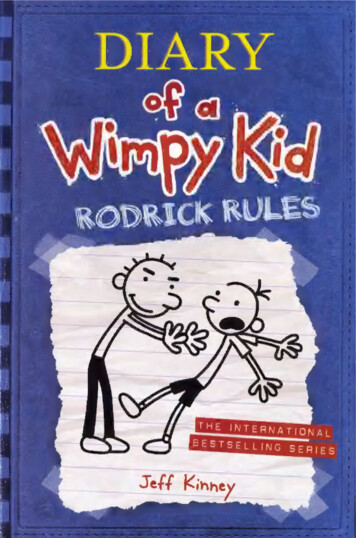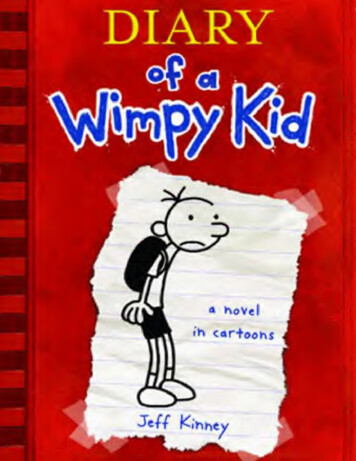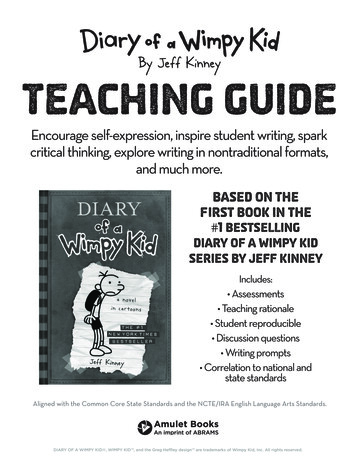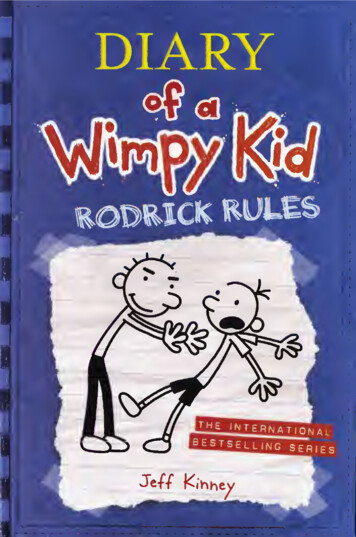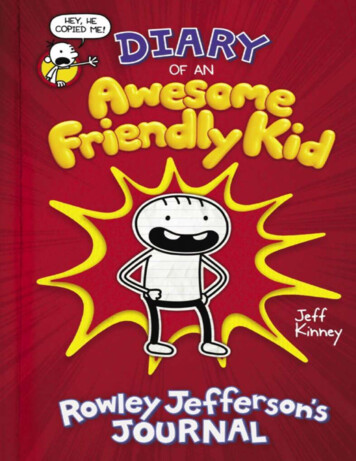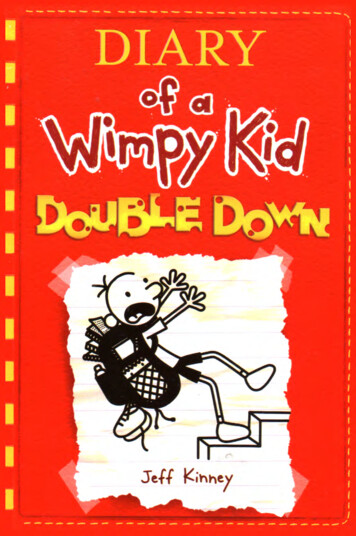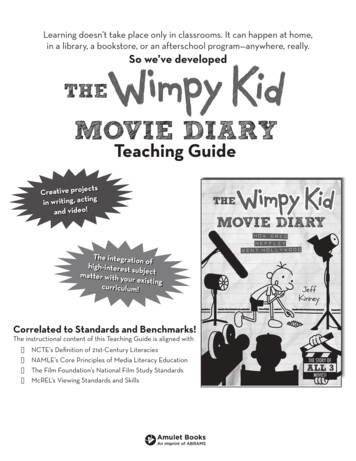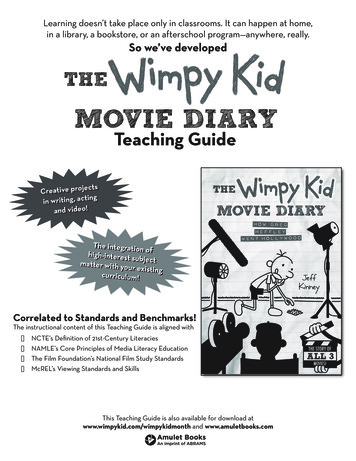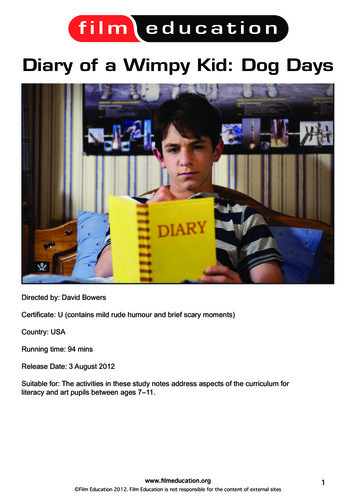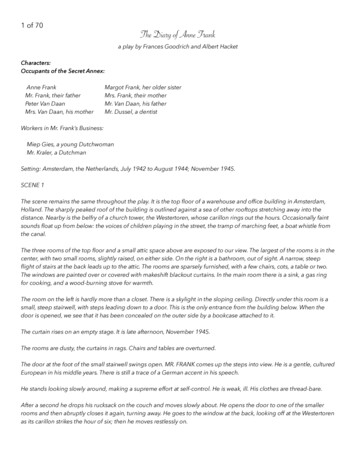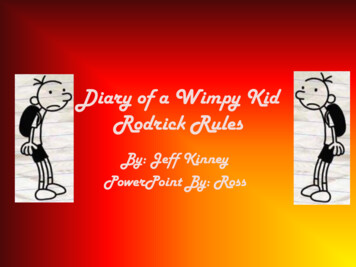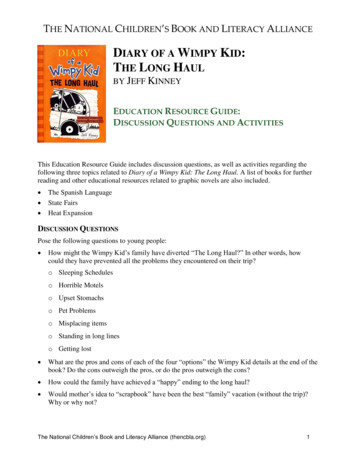
Transcription
THE NATIONAL CHILDREN’S BOOK AND LITERACY ALLIANCEDIARY OF A WIMPY KID:THE LONG HAULBY JEFF KINNEYEDUCATION RESOURCE GUIDE:DISCUSSION QUESTIONS AND ACTIVITIESThis Education Resource Guide includes discussion questions, as well as activities regarding thefollowing three topics related to Diary of a Wimpy Kid: The Long Haul. A list of books for furtherreading and other educational resources related to graphic novels are also included. The Spanish LanguageState FairsHeat ExpansionDISCUSSION QUESTIONSPose the following questions to young people: How might the Wimpy Kid’s family have diverted “The Long Haul?” In other words, howcould they have prevented all the problems they encountered on their trip?o Sleeping Scheduleso Horrible Motelso Upset Stomachso Pet Problemso Misplacing itemso Standing in long lineso Getting lost What are the pros and cons of each of the four “options” the Wimpy Kid details at the end of thebook? Do the cons outweigh the pros, or do the pros outweigh the cons? How could the family have achieved a “happy” ending to the long haul? Would mother’s idea to “scrapbook” have been the best “family” vacation (without the trip)?Why or why not?The National Children’s Book and Literacy Alliance (thencbla.org)1
Education Resource Guide for Author and Illustrator Jeff Kinney What were the Wimpy Kid’s mother and dad hoping to achieve on the trip? How could theyhave achieved this goal for the family in a less “disastrous” manner?ACTIVITY: THE SPANISH LANGUAGEMany kids in countries around the world are bi– or even tri–lingual! As the Wimpy Kid found out,sometimes it is very important to understand, speak, or write another language! Ask young people ifthey want to join other kids around the world who speak more than one language. If so, check outthe free Spanish-learning websites on TakeLessons.com and get started.But, don’t stop there! Invite your students to set out on an adventure, just like the Wimpy Kid, andfind out where Spanish is spoken around the world. You may find the following resources helpful. “Spanish Speaking World” “Spanish Speaking Countries” on Google.com “Spanish Speaking Countries” on MapsoftheWorld.com (see illustration below)While visiting the Google listing, above, students can choose a country they would like to visit.Learn more about the country at the CIA World Factbook. Or, students can learn about Spain and itsculture in the Spanish Culture page in the BBC website.Either way, help students complete a passport for the country chosen by either downloading thePassport for Kids activity or creating your own similar activity. As they complete the passport, askstudents to think of what they would need to be able to say or to ask those persons living in thechosen country during their visit. Ask students to write that communication down and type it in aword processor (such as Microsoft Word).Finally, ask students to read and speak their imagined conversation in Spanish! Highlight and copythe conversation from their word processing file, then paste it in Google Translate. Be sure tochoose the buttons to translate from English to Spanish, and Wa-Lah! Speak Spanish!Spanish Language Map by Usergreatpower [Public domain], via Wikimedia Commons2The National Children’s Book and Literacy Alliance (thencbla.org)
Education Resource Guide for Author and Illustrator Jeff KinneyACTIVITY: STATE FAIRSState Fairs are some of the most educational events in our country (and you probably will NOTcome away with a pig)! Three of the most famous, according to the National Education Association,are: The Eastern States Exposition (New England), The Texas State Fair, and The Arizona StateFair. Thanks to technology, you can now visit these Fairs virtually and participate in activities.First, why not join the kids of New England and invite young people to try their hands at a buttersculpture? Churn your own butter in the cafeteria (or a kitchen) beforehand, and, then, in groups orindividually, set aside a day to “sculpt away!” (You can use everyday objects, such as butter knives,or borrow tools from your art teacher). Hold a balloted vote for the best sculpture and award blue,red, and white ribbons.Second, along with kids from Texas, invite young people to go on a “Food Race” (but don’t eatyour shoes when you wear a hole in one or both)! Learn how food “races” from the farm to YOURown table by using the State Fair of Texas Curriculum Guide, visiting the state or local fair in yourown locale, and inserting your state or community name everywhere you see the word TEXAS(within the guide). Have fun “racing” within the food chain (same as your Texas friends).Third, the Arizona State Fair is well-known for music, music, music! Just look at this list ofperformers over the years. Ask students to choose one year from this listing and look up informationabout each performer (or group) using KidzSearch.com. Ask students to see if any of the musiciansgrew up or live in your state. If so, write them down.Next, have the class or learning group add each name discovered to a “Musicians From ”listing (make sure all years are researched). After preparing your state listing as a group, togetherlisten to one song from each performer on You Tube. As a class activity, decide which genre ofmusic the performer(s) play(s), and list it beside the correct name on your state list. Post the list inyour classroom with pride! (See the example below.)Visit the website for your own state fair and discover if any of these performers are scheduled toappear this year.MUSICIANS FROM NORTH CAROLINANameGenreRonnie MilsapCountryScott McCrearyCountryThe National Children’s Book and Literacy Alliance (thencbla.org)3
Education Resource Guide for Author and Illustrator Jeff KinneyACTIVITY: HEAT EXPANSIONDo your students want to understand WHY the sticky bun container blew up in the Wimpy Kidfamily vehicle? They can find out in “Getting Hotter Getting Bigger” on Physics4kids.com.Then, invite young people to become young physicists and learn all about thermodynamics byreading ALL these pages (10 all together) on Physics4Kids.com. Watch all the videos, too, and besure and take the quiz afterwards.Don’t stop there! Invite students to “fool” their friends with a magic trick based in thermodynamics.Place a bottle and a coin (a bit larger than the opening of the bottle) in cold water for a few minutes.Then, take both out of the water. Place the coin on top of the bottle. Wrap your hands around thebottle for a minute or two. Watch what happens to the coin as the bottle heats up. It “magically”dances!As a class, think of some other experiments that demonstrate the principles of thermodynamics (butare safe for all)! Start with these “Thermal Expansion” examples on HelloKids.com.Be sure to record both your experiment and your observations, just like a true scientist. You mightuse the following Our Question:Our Equipment:Method (What did we do?):My Predictions (What I think will happen):Results:4The National Children’s Book and Literacy Alliance (thencbla.org)
Education Resource Guide for Author and Illustrator Jeff KinneyREAD AND LEARN MOREMORE BOOKS BY JEFF KINNEYIf The Long Haul is your first introduction to The Wimpy Kid, be sure to check-out his “history” byreading the series in order of publication. Diary of A Wimpy Kid – 2007 Diary of A Wimpy Kid: Rodrick Rules – 2008 Diary of A Wimpy Kid: The Last Straw – 2009 Diary of A Wimpy Kid: Dog Days – 2009 Diary of A Wimpy Kid: The Ugly Truth – 2010 Diary of A Wimpy Kid: Cabin Fever – 2011 Diary of A Wimpy Kid: he Third Wheel – 2012 Diary of A Wimpy Kid: Hard Luck – 2013 Diary of A Wimpy Kid: The Long Haul – 2014 Diary of A Wimpy Kid: Old School – 2015 Diary of A Wimpy Kid: Double Down – 2016 Diary of A Wimpy Kid: he Getaway – 2017OUR WHITE HOUSE: LOOKING IN, LOOKING OUTLearn more about other “wimpy kid” adventures, kids living in or visiting The White House that is,at the following pages within the acclaimed children’s book Our White House: Looking In, LookingOut (Candlewick Press): “Storming Down the Stairs” by Albert Marrin on pages 98-9. Also see the accompanyingillustration by Chris Van Dusen on pages 96-7. “A Note for the President” by Jerry Spinelli (illustrated by Terry Widener) on pages 141-3. “The Kennedy White House” by Barbara Harrison (illustrated by Steve Johnson and LouFancher) on pages 152-3. “My Room” by Lynda Johnson Robb (illustrated by Jane Dyer) on pages 170-2.The National Children’s Book and Literacy Alliance (thencbla.org)5
Education Resource Guide for Author and Illustrator Jeff KinneyONLINE EDUCATIONAL RESOURCESThe following online resources provide information related to graphic novels and comics.Comics in Education by Gene Luen Yanghttp://www.humblecomics.com/comicsedu/Articles and Interviews by Brigid AlversonBrigid Alverson writes about comics and graphic novels for School Library Journal. She is theeditor of the Good Comics for Kids blog and has been reading comics since she was four. She hasan MFA in printmaking and has worked as a book editor and a newspaper reporter; now she isassistant to the mayor of Melrose, Massachusetts. In addition to editing GC4K, she writes aboutcomics and graphic novels at MangaBlog, SLJTeen, Publishers Weekly Comics World, ComicBook Resources, MTV Geek, and Good E-Reader.com. “Teaching With Graphic e-graphic-advantage-teaching-with-graphic-novels/ “Good Comics for /16/brigid-alverson-on-good-comics-for-kids/ “Just Another Day in an LGBTQ another-day-in-an-lgbtq-comic/ “The People’s Comics: Using the Graphic Format to Teach About Current about-current-events/ “Teaching with Science hing-with-science-comics/ “A nonfiction roundup of Graphic ction-graphic-novels-give-these-to-fans-of-march/ “The immigrant experience in graphic hic-novels-portray-bicultural-america/ “Graphic novels that tie in with video e-changers-books-based-on-video-games/ Brigid Alverson Talk on “Graphic Novels for en/ “Interview: Eric Kallenborn on Graphic Novels in the vels-in-the-classroom/6The National Children’s Book and Literacy Alliance (thencbla.org)
Education Resource Guide for Author and Illustrator Jeff KinneyGRAPHIC NOVEL BOOKLISTSThe following online booklists from authoritative sources recommend graphic novels for differentage levels: “Graphic Novels: Read the /graphic-novels-read-pictures“Graphic Novels for Kids: Classroom Ideas, Booklists, and ��19 Graphic Novels That Engage Students and Keep Them p-them-reading“Graphic Novels: Selected Titles for Children and ilListBooks.asp?idBookLists 192“Graphic aphic-novels#“The Best Comics for Your Classroom: A List for All Grade hic Novels Reading Lists: 2016 urces/book-lists/graphicnovels2016“Great Graphic Novels for Middle -graphic-novels-middle-school/“Powerful Graphic Novels for Middle -graphic-novels-middle-school“Top 10 Graphic Novels top-10-graphic-novels-2015/“Top 10 Graphic Novels top-10-graphic-novels-2016/“Comic Relief: Thirty-Nine Graphic Novels that Kids Can’t at-kids-cant-resist/“Graphic Novels for (Really) Young The National Children’s Book and Literacy Alliance (thencbla.org)7
Education Resource Guide for Author and Illustrator Jeff KinneyARTICLES: USING GRAPHIC NOVELS IN THE CLASSROOMThe following online articles provide information about using comics and graphic novels in theclassrooms: “Graphic Novels for Young Kids” by Reading ic-novels-young-kids“Graphic Novel Conversation with ESL Teacher Colleen life/graphic-novel-conversion“Using Comics and Graphic Novels in the Classroom” by �Eek! Comics in the Classroom” by Linda Starrhttp://www.educationworld.com/a curr/profdev/profdev105.shtml“Comic Book Science in the Classroom” NPR Broadcast with Sarah ?storyId 4581832“'Hamlet' too hard? Try a comic book” by Teresa egn.html“Graphic Novels in the Classroom: A Teacher ng-graphic-novels/“Graphic Novels: The Bridge Between Visual and Print Media” by Stan ween-visual-and-print-mediaONLINE RESOURCES FOR COMIC STRIPSThe following online websites and articles provide lesson plans for creating comic strips.Websites Comics in the Classroonhttp://comicsintheclassroom.net/Teaching Comicshttp://www.teachingcomics.org/Articles and Lesson Plans “Comic Strip Creations Lesson plans/teaching-content/comic-strip-creations/ “Comic html?tab 4 “Comics in the Classroom as an Introduction to Genre genre-188.html “Comics in the Classroom as an Introduction to Narrative ion-narrative-223.html8The National Children’s Book and Literacy Alliance (thencbla.org)
Education Resource Guide for Author and Illustrator Jeff Kinney “Book Report Alternative: Comic Strips and Cartoon ic195.html“Using Cartoons and Comic /using-cartoons-comic-strips“Creating Comic ors/lessons/grade-3-4/creating comic strips.aspx“The Secret in the Cellar: A Written in Bone Forensic Mystery from Colonial /comic/index.html“Creative Writing Using Comics Lesson p0013ABOUT THE EDUCATION RESOURCE GUIDE CONTRIBUTORRenée Critcher Lyons is an assistant professor in the School Library Media Program at EastTennessee State University, teaching children’s and young adult literature to future librarians. Priorto her appointment at ETSU, she served as both a school (elementary, middle, and high school) andinstructional (community college) librarian. Reneé is the author of three books: Teaching Civics inthe Library: An Instructional and Historical Guide for School and Public Librarians (McFarland,2015); Foreign-Born American Patriots: Sixteen Volunteer Leaders in the Revolutionary War(2013); and The Revival of Banned Dances: A Worldwide Study (2012). She is a graduate ofVermont College of Fine Arts (MFA in Writing for Children and Young Adults) and AppalachianState University (Master of Library Science). 2017 by Renée Critcher Lyons and Mary Brigid Barrett; The National Children’s Book and LiteracyAllianceThe National Children’s Book and Literacy Alliance (thencbla.org)9
Diary of A Wimpy Kid: Cabin Fever – 2011 Diary of A Wimpy Kid: he Third Wheel – 2012 Diary of A Wimpy Kid: Hard Luck – 2013 Diary of A Wimpy Kid: The Long Haul – 2014 Diary of A Wimpy Kid: Old School – 2015 Diary of A Wimpy Kid: Double Down – 2016 Diary of A
